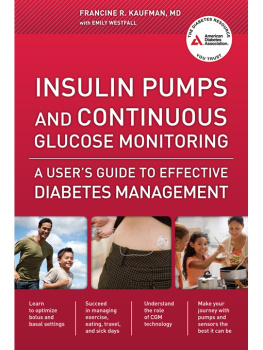Contents

Individualized
Diabetes
Management
A Guide for Primary Care
Individualized
Diabetes
Management
A Guide for Primary Care
Anthony H. Barnett
Jenny Grice

CRC Press
Taylor & Francis Group
6000 Broken Sound Parkway NW, Suite 300
Boca Raton, FL 33487-2742
2016 by Taylor & Francis Group, LLC
CRC Press is an imprint of Taylor & Francis Group, an Informa business
No claim to original U.S. Government works
Printed on acid-free paper
Version Date: 20160719
International Standard Book Number-13: 978-1-4987-6209-0 (Paperback)
This book contains information obtained from authentic and highly regarded sources. While all reasonable efforts have been made to publish reliable data and information, neither the author[s] nor the publisher can accept any legal responsibility or liability for any errors or omissions that may be made. The publishers wish to make clear that any views or opinions expressed in this book by individual editors, authors or contributors are personal to them and do not necessarily reflect the views/opinions of the publishers. The information or guidance contained in this book is intended for use by medical, scientific or health-care professionals and is provided strictly as a supplement to the medical or other professionals own judgement, their knowledge of the patients medical history, relevant manufacturers instructions and the appropriate best practice guidelines. Because of the rapid advances in medical science, any information or advice on dosages, procedures or diagnoses should be independently verified. The reader is strongly urged to consult the relevant national drug formulary and the drug companies and device or material manufacturers printed instructions, and their websites, before administering or utilizing any of the drugs, devices or materials mentioned in this book. This book does not indicate whether a particular treatment is appropriate or suitable for a particular individual. Ultimately it is the sole responsibility of the medical professional to make his or her own professional judgements, so as to advise and treat patients appropriately. The authors and publishers have also attempted to trace the copyright holders of all material reproduced in this publication and apologize to copyright holders if permission to publish in this form has not been obtained. If any copyright material has not been acknowledged please write and let us know so we may rectify in any future reprint.
Except as permitted under U.S. Copyright Law, no part of this book may be reprinted, reproduced, transmitted, or utilized in any form by any electronic, mechanical, or other means, now known or hereafter invented, including photocopying, microfilming, and recording, or in any information storage or retrieval system, without written permission from the publishers.
For permission to photocopy or use material electronically from this work, please access www.copyright.com (http://www.copyright.com/) or contact the Copyright Clearance Center, Inc. (CCC), 222 Rosewood Drive, Danvers, MA 01923, 978-750-8400. CCC is a not-forprofit organization that provides licenses and registration for a variety of users. For organizations that have been granted a photocopy license by the CCC, a separate system of payment has been arranged.
Trademark Notice: Product or corporate names may be trademarks or registered trademarks, and are used only for identification and explanation without intent to infringe.
Library of Congress Cataloging.in.Publication Data
Names: Barnett, A. H. (Anthony H.), 1951- author. | Grice, Jenny, author.
Title: Individualized diabetes management : a guide for primary care /
Anthony H. Barnett and Jenny Grice.
Description: Boca Raton : CRC Press, [2017] | Includes bibliographical
references.
Identifiers: LCCN 2016032387 | ISBN 9781498762090 (pbk. : alk. paper)
Subjects: | MESH: Diabetes Mellitus, Type 2-- epidemiology | Diabetes
Mellitus, Type 2--therapy | Precision Medicine | Primary Health Care |
Great Britain
Classification: LCC RC660.4 | NLM WK 810 | DDC 616.4/62-- dc23
LC record available at https://lccn.loc.gov/2016032387
Visit the Taylor & Francis Web site at
http://www.taylorandfrancis.com
and the CRC Press Web site at
http://www.crcpress.com
Contents
Professor Anthony H. Barnett is recognised as an international expert in this area and has written many papers and lectured extensively nationally and abroad. He has acted as an expert advisor to National Institute for Health and Care Excellence (NICE) on new drugs and has worked with the European Medicines Agency and other related bodies. Indeed, he represented the European Association for the Study of Diabetes (EASD) at the European Medicines Agency on diabetes-related drugs between 2006 and 2011. He is presently listed in the top five researchers in Type 2 Diabetes worldwide.
Jenny Grice is an accomplished medical writer and has supported Professor Barnett on many of his projects including co-authoring a bespoke book on new mechanisms in glucose control, published in 2011.
Type 2 diabetes is at crisis levels and shows no signs of abating with no country and no section of society immune to the disease. In the United Kingdom, 2016 began with the news that the number of people with diabetes had exceeded four million for the first time (QOF et al., 2015). The need to tackle this serious health condition has therefore never been so urgent.
Although we have the evidence and the tools to prevent and manage type 2 diabetes, these are not routinely employed, and tragically we continue to see too many people with diabetes suffering serious complications, and even premature death. The challenge is to reduce the human and financial costs through early diagnosis and effective management and to prevent new cases of diabetes from developing.
The World Innovation Summit for Health 2015 Diabetes Forum identified three policy goals to both reduce the incidence of diabetes and better manage established disease and its complications (Colagiuri et al., 2015):
Improve disease management for people with diabetes to reduce complication rates.
Establish effective surveillance to identify and support those at risk of type 2 diabetes.
Introduce a range of interventions that help to create an environment focussed on prevention.
IMPROVE DISEASE MANAGEMENT
In the past two decades, a greater understanding of diabetes has facilitated the development of new drug classes that target specific metabolic pathways such as the thiazolidinediones, dipeptidyl peptidase-4 inhibitors, glucagon-like peptide-1 receptor agonists and sodiumglucose cotransporter type 2 inhibitors, as well as a range of new insulins (Tahrani et al., 2016). Many of these are now available as combination treatments allowing us to combine drugs with different mechanisms of action into simpler treatment regimens. We are no longer limited in what we can offer to patients, and it is therefore much easier to develop personalised management regimens that match treatments to the individual needs of patients and their stage of disease. The clinical efficacy of a treatment remains integral, but what is more important to the individual is how it fits in with his or her daily life, and here ease of use, tolerability and safety are of great importance. Tailored treatment plans combined with education improve disease management and help prevent complications.










